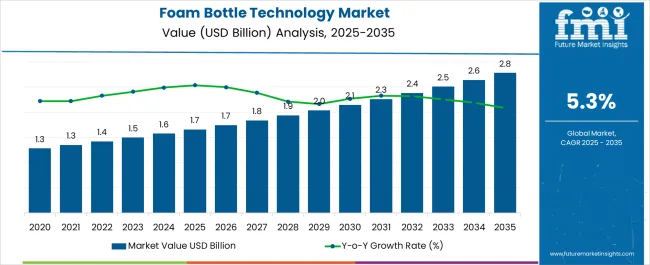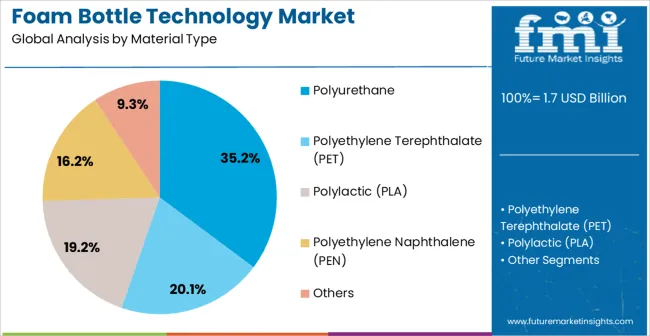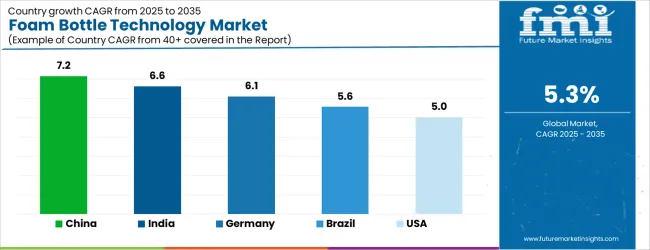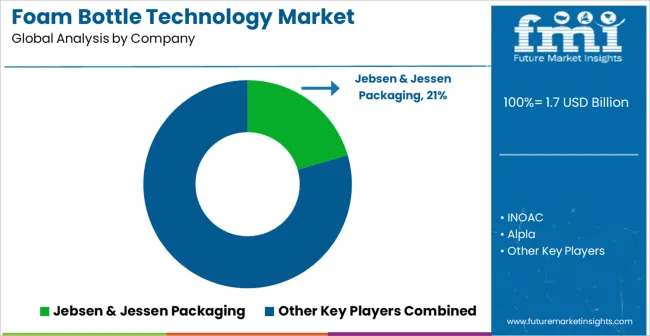The Foam Bottle Technology Market is estimated to be valued at USD 1.7 billion in 2025 and is projected to reach USD 2.8 billion by 2035, registering a compound annual growth rate (CAGR) of 5.3% over the forecast period.

| Metric | Value |
|---|---|
| Foam Bottle Technology Market Estimated Value in (2025 E) | USD 1.7 billion |
| Foam Bottle Technology Market Forecast Value in (2035 F) | USD 2.8 billion |
| Forecast CAGR (2025 to 2035) | 5.3% |
The Foam Bottle Technology market is experiencing robust growth, driven by increasing demand for lightweight, durable, and sustainable packaging solutions across various industries. Rising consumer preference for convenience, portability, and eco-friendly packaging is accelerating adoption. Advanced foam materials and production processes are enabling the creation of bottles that provide thermal insulation, impact resistance, and chemical stability while reducing overall material consumption.
The market is further supported by technological innovations such as extrusion moulding, injection moulding, and hybrid fabrication techniques that enhance efficiency, scalability, and design flexibility. Growth in the food and beverage sector, driven by rising consumption of packaged drinks and ready-to-eat products, is significantly influencing market expansion.
Increasing regulatory emphasis on sustainable packaging and recycling initiatives is also encouraging manufacturers to invest in high-performance foam materials and modern production technologies As industries focus on reducing carbon footprint and enhancing product shelf-life, the Foam Bottle Technology market is poised for sustained growth, with continuous innovation in materials, design, and processing methods shaping the future landscape.
The foam bottle technology market is segmented by material type, end-use industry, technology type, and geographic regions. By material type, foam bottle technology market is divided into Polyurethane, Polyethylene Terephthalate (PET), Polylactic (PLA), Polyethylene Naphthalene (PEN), and Others. In terms of end-use industry, foam bottle technology market is classified into Food & Beverage, Personal & Cosmetic, Pharmaceutical And Healthcare, and Others. Based on technology type, foam bottle technology market is segmented into Extrusion Moulding Technology, Blow Moulding Technology, and Others. Regionally, the foam bottle technology industry is classified into North America, Latin America, Western Europe, Eastern Europe, Balkan & Baltic Countries, Russia & Belarus, Central Asia, East Asia, South Asia & Pacific, and the Middle East & Africa.

The polyurethane material type segment is projected to hold 35.2% of the market revenue in 2025, establishing it as the leading material type. Growth in this segment is being driven by polyurethane’s superior mechanical properties, including flexibility, durability, and chemical resistance, which make it suitable for high-performance foam bottles. The material’s lightweight nature reduces shipping and handling costs while providing excellent insulation and protection for sensitive contents.
Polyurethane’s adaptability to various production technologies, including extrusion and moulding, further strengthens its market position. Its ability to maintain structural integrity under varying temperatures and pressures ensures reliable performance across different end-use applications.
Increasing demand for sustainable and recyclable packaging solutions has encouraged the adoption of polyurethane-based foams As manufacturers continue to prioritize performance, cost efficiency, and environmental compliance, polyurethane is expected to maintain its leading share in the foam bottle market, supported by innovations in formulation, process optimization, and scalable production techniques.

The food and beverage end-use industry segment is anticipated to account for 42.7% of the market revenue in 2025, making it the largest end-use category. Growth is being driven by the rising consumption of packaged beverages, ready-to-drink products, and liquid foods that require durable, insulated, and hygienic packaging solutions. Foam bottles provide thermal insulation, impact resistance, and product safety, which are essential for preserving quality and freshness during transportation and storage.
Manufacturers are increasingly adopting foam bottles to reduce material usage, lower transportation costs, and meet sustainability standards. The ability to customize bottle design and functionality through advanced foam materials and processing technologies enhances their appeal to both producers and consumers.
Regulatory guidelines on food safety, packaging standards, and environmental compliance further support adoption As demand for convenient, lightweight, and high-performance packaging solutions continues to grow in the food and beverage sector, this segment is expected to remain a primary driver of market growth, reinforced by innovation in materials and production methods.

The extrusion moulding technology segment is projected to hold 51.4% of the market revenue in 2025, establishing it as the leading technology type. Its growth is being driven by the ability to produce high-quality foam bottles at scale while maintaining consistent dimensional accuracy and structural integrity. Extrusion moulding allows precise control over material density, wall thickness, and thermal properties, which is critical for applications requiring insulation, durability, and chemical resistance.
The process is cost-effective and adaptable to a wide range of foam materials, including polyurethane, enabling efficient mass production. Manufacturers benefit from reduced waste generation, shorter cycle times, and enhanced design flexibility, allowing for customized shapes and sizes.
Rising demand for sustainable, lightweight, and durable packaging across the food and beverage, personal care, and pharmaceutical industries further strengthens adoption As companies prioritize efficiency, product safety, and environmental compliance, extrusion moulding technology is expected to remain the dominant method for producing foam bottles, driving market growth in the coming years.
The foam bottle technology market is anticipated to witness an unprecedented surge in the forthcoming years owing to the improving lifestyle and rising disposable income. People are willing to invest in products that upgrade their hygiene levels. The rising focus on cleanliness is expected to boost the market growth for foam dispensers, simultaneously raising the market share of foam bottle technology.
In addition, there is a rising need for convenient packaging for different beverages, and foam bottles are the most suited. Therefore, the manufacturers prevailing in the market have many opportunities for strengthening their foothold in the global foam bottle technology market.
The market is characterized by various well-established players and several small and medium players. These market players face stiff competition from each other as some are among the leading manufacturers of soap dispensers and have a large customer base.
These players have strong and vast distribution networks to reach out to a wide target audience. The impact of leading companies on the market is quite high, as most of them have a global presence. Many market players are adopting strategies, such as product launches and acquisitions, to strengthen their position and boost revenue growth.
The manufacturers in the foam bottle technology market are using advanced technology to reduce the need for chemical resins, owing to the international regulatory norms and cleaner packaging standards that do not harm the environment.
Therefore, it is anticipated that the market players are likely to engage in organic growth strategies like intense promotional campaigns across several online and offline platforms, which will gradually lead to significant growth of the foam bottle technology market in the coming years.

| Country | CAGR |
|---|---|
| China | 7.2% |
| India | 6.6% |
| Germany | 6.1% |
| Brazil | 5.6% |
| USA | 5.0% |
| UK | 4.5% |
| Japan | 4.0% |
The Foam Bottle Technology Market is expected to register a CAGR of 5.3% during the forecast period, exhibiting varied country level momentum. China leads with the highest CAGR of 7.2%, followed by India at 6.6%. Developed markets such as Germany, France, and the UK continue to expand steadily, while the USA is likely to grow at consistent rates. Japan posts the lowest CAGR at 4.0%, yet still underscores a broadly positive trajectory for the global Foam Bottle Technology Market.
In 2024, Germany held a dominant revenue in the Western Europe market and is expected to grow with a CAGR of 6.1%. The USA Foam Bottle Technology Market is estimated to be valued at USD 577.6 million in 2025 and is anticipated to reach a valuation of USD 577.6 million by 2035. Sales are projected to rise at a CAGR of 0.0% over the forecast period between 2025 and 2035. While Japan and South Korea markets are estimated to be valued at USD 81.4 million and USD 50.6 million respectively in 2025.

| Item | Value |
|---|---|
| Quantitative Units | USD 1.7 Billion |
| Material Type | Polyurethane, Polyethylene Terephthalate (PET), Polylactic (PLA), Polyethylene Naphthalene (PEN), and Others |
| End-Use Industry | Food & Beverage, Personal & Cosmetic, Pharmaceutical And Healthcare, and Others |
| Technology Type | Extrusion Moulding Technology, Blow Moulding Technology, and Others |
| Regions Covered | North America, Europe, Asia-Pacific, Latin America, Middle East & Africa |
| Country Covered | United States, Canada, Germany, France, United Kingdom, China, Japan, India, Brazil, South Africa |
| Key Companies Profiled | Jebsen & Jessen Packaging, INOAC, Alpla, Plastic Technologies, PlasticsToday, Armacell, and Aroma Bottles |
The global foam bottle technology market is estimated to be valued at USD 1.7 billion in 2025.
The market size for the foam bottle technology market is projected to reach USD 2.8 billion by 2035.
The foam bottle technology market is expected to grow at a 5.3% CAGR between 2025 and 2035.
The key product types in foam bottle technology market are polyurethane, polyethylene terephthalate (pet), polylactic (pla), polyethylene naphthalene (pen) and others.
In terms of end-use industry, food & beverage segment to command 42.7% share in the foam bottle technology market in 2025.






Our Research Products

The "Full Research Suite" delivers actionable market intel, deep dives on markets or technologies, so clients act faster, cut risk, and unlock growth.

The Leaderboard benchmarks and ranks top vendors, classifying them as Established Leaders, Leading Challengers, or Disruptors & Challengers.

Locates where complements amplify value and substitutes erode it, forecasting net impact by horizon

We deliver granular, decision-grade intel: market sizing, 5-year forecasts, pricing, adoption, usage, revenue, and operational KPIs—plus competitor tracking, regulation, and value chains—across 60 countries broadly.

Spot the shifts before they hit your P&L. We track inflection points, adoption curves, pricing moves, and ecosystem plays to show where demand is heading, why it is changing, and what to do next across high-growth markets and disruptive tech

Real-time reads of user behavior. We track shifting priorities, perceptions of today’s and next-gen services, and provider experience, then pace how fast tech moves from trial to adoption, blending buyer, consumer, and channel inputs with social signals (#WhySwitch, #UX).

Partner with our analyst team to build a custom report designed around your business priorities. From analysing market trends to assessing competitors or crafting bespoke datasets, we tailor insights to your needs.
Supplier Intelligence
Discovery & Profiling
Capacity & Footprint
Performance & Risk
Compliance & Governance
Commercial Readiness
Who Supplies Whom
Scorecards & Shortlists
Playbooks & Docs
Category Intelligence
Definition & Scope
Demand & Use Cases
Cost Drivers
Market Structure
Supply Chain Map
Trade & Policy
Operating Norms
Deliverables
Buyer Intelligence
Account Basics
Spend & Scope
Procurement Model
Vendor Requirements
Terms & Policies
Entry Strategy
Pain Points & Triggers
Outputs
Pricing Analysis
Benchmarks
Trends
Should-Cost
Indexation
Landed Cost
Commercial Terms
Deliverables
Brand Analysis
Positioning & Value Prop
Share & Presence
Customer Evidence
Go-to-Market
Digital & Reputation
Compliance & Trust
KPIs & Gaps
Outputs
Full Research Suite comprises of:
Market outlook & trends analysis
Interviews & case studies
Strategic recommendations
Vendor profiles & capabilities analysis
5-year forecasts
8 regions and 60+ country-level data splits
Market segment data splits
12 months of continuous data updates
DELIVERED AS:
PDF EXCEL ONLINE
Foamer Bottle Market Size and Share Forecast Outlook 2025 to 2035
Market Share Breakdown of Foamer Bottle Manufacturers
Foam Type Vacuum Gripping System Market Size and Share Forecast Outlook 2025 to 2035
Foam Mixing Machine Market Size and Share Forecast Outlook 2025 to 2035
Foam Market Size and Share Forecast Outlook 2025 to 2035
Foam-Free Pad Formers Market Size and Share Forecast Outlook 2025 to 2035
Foam Cups Market Size and Share Forecast Outlook 2025 to 2035
Bottle Sealing Wax Market Size and Share Forecast Outlook 2025 to 2035
Bottle Filling Machines Market Size and Share Forecast Outlook 2025 to 2035
Foaming Agents Market Size and Share Forecast Outlook 2025 to 2035
Bottle Shippers Market Size and Share Forecast Outlook 2025 to 2035
Bottled Water Packaging Market Size and Share Forecast Outlook 2025 to 2035
Foam Glass Granulate Market Size and Share Forecast Outlook 2025 to 2035
Foam Plastics Market Size and Share Forecast Outlook 2025 to 2035
Foaming Creamer Market Size and Share Forecast Outlook 2025 to 2035
Foam Tape Market Size and Share Forecast Outlook 2025 to 2035
Foam Glass Market Size and Share Forecast Outlook 2025 to 2035
Foamer Pump Market Size, Share & Forecast 2025 to 2035
Bottle Sticker Labelling Machine Market Size and Share Forecast Outlook 2025 to 2035
Foam Food Container Market Size and Share Forecast Outlook 2025 to 2035

Thank you!
You will receive an email from our Business Development Manager. Please be sure to check your SPAM/JUNK folder too.
Chat With
MaRIA